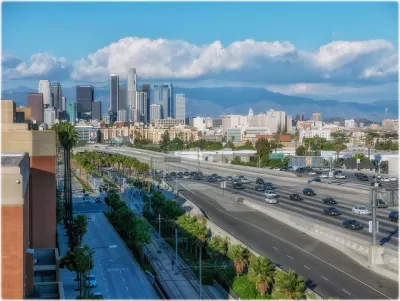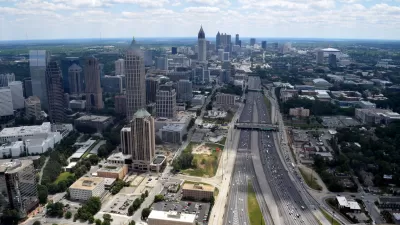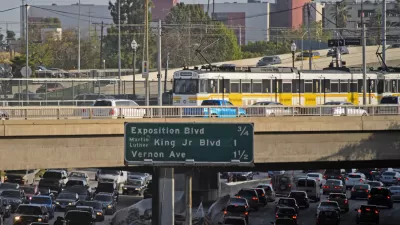The racist history of planning in Los Angeles is particularly evident in the way Interstate freeways were planned in the region.

You've probably heard that the construction of the nation's interstate freeway system was racist both in intent and consequence, but Los Angeles' example provides evidence of just how tragically effective they were to those ends.
After recounting the many monuments that have been pulled down by protestors in recent weeks, in a "moment of truth telling," writes Mathew Fleischer, cities like Los Angeles need to reckon with another monument to racism: urban freeways.
"Most Angelenos don’t think about it as we spew carbon monoxide across the city on our way from Point A to Point B, but our toxic exhaust fumes feed into a pot of racism that’s been stewing for nearly a century," writes Fleischer.
After recalling numerous planning decisions that took Black wealth and property around the Los Angeles region as it boomed in population in the first half of the 20th century, Fleischer mentions the coup de grace, the Interstate Highway Act of 1944, signed on June 29, 1956.
"When the 1944 Federal-Aid Highway Act allocated funds for 1,938 miles of freeways in California, planners used the opportunity, with full federal support, to obliterate as much as possible the casual mingling of the races."
Fleischer tells a lot more of the history of racial segregation and disempowerment as manifest by the freeways in Los Angeles, referencing two books along the way for potential additional reading: If You Build It, They Will Move, by Gilbert Estrada, and The Color of Law, by Richard Rothstein.
Eventually, Felischer ties the history of freeways in Los Angeles back to the contemporary moment of truth telling.
"Remedying the enduring effects of white supremacy will be far more challenging — in progressive Los Angeles as much as in Alabama or Mississippi. And it will be impossible if we aren’t honest about the history that made things the way they are —and the massive undertaking it will require to remedy them."
FULL STORY: Want to tear down insidious monuments to racism and segregation? Bulldoze L.A. freeways

Planetizen Federal Action Tracker
A weekly monitor of how Trump’s orders and actions are impacting planners and planning in America.

Map: Where Senate Republicans Want to Sell Your Public Lands
For public land advocates, the Senate Republicans’ proposal to sell millions of acres of public land in the West is “the biggest fight of their careers.”

Restaurant Patios Were a Pandemic Win — Why Were They so Hard to Keep?
Social distancing requirements and changes in travel patterns prompted cities to pilot new uses for street and sidewalk space. Then it got complicated.

Platform Pilsner: Vancouver Transit Agency Releases... a Beer?
TransLink will receive a portion of every sale of the four-pack.

Toronto Weighs Cheaper Transit, Parking Hikes for Major Events
Special event rates would take effect during large festivals, sports games and concerts to ‘discourage driving, manage congestion and free up space for transit.”

Berlin to Consider Car-Free Zone Larger Than Manhattan
The area bound by the 22-mile Ringbahn would still allow 12 uses of a private automobile per year per person, and several other exemptions.
Urban Design for Planners 1: Software Tools
This six-course series explores essential urban design concepts using open source software and equips planners with the tools they need to participate fully in the urban design process.
Planning for Universal Design
Learn the tools for implementing Universal Design in planning regulations.
Heyer Gruel & Associates PA
JM Goldson LLC
Custer County Colorado
City of Camden Redevelopment Agency
City of Astoria
Transportation Research & Education Center (TREC) at Portland State University
Camden Redevelopment Agency
City of Claremont
Municipality of Princeton (NJ)





























